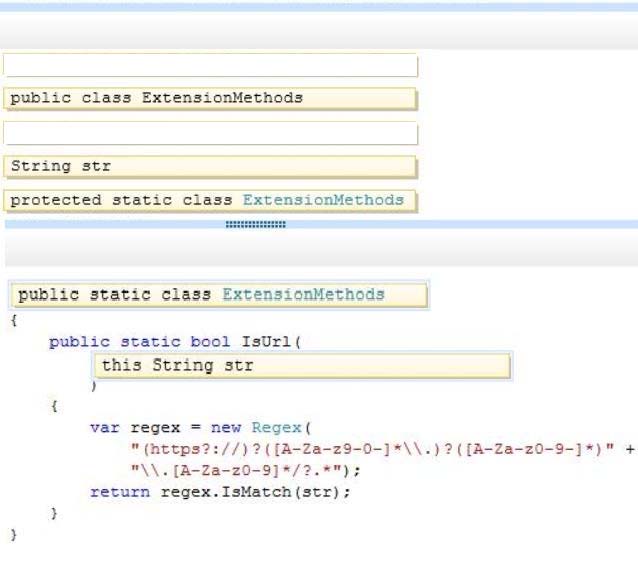Microsoft 70-483 Exam Practice Questions (P. 3)
- Full Access (271 questions)
- Six months of Premium Access
- Access to one million comments
- Seamless ChatGPT Integration
- Ability to download PDF files
- Anki Flashcard files for revision
- No Captcha & No AdSense
- Advanced Exam Configuration
Question #11
You are creating an application that manages information about zoo animals. The application includes a class named Animal and a method named Save.
The Save() method must be strongly typed. It must allow only types inherited from the Animal class that uses a constructor that accepts no parameters.
You need to implement the Save() method.
Which code segment should you use?
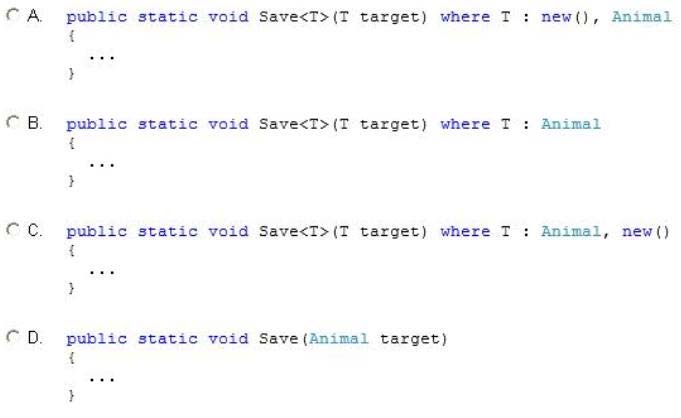
The Save() method must be strongly typed. It must allow only types inherited from the Animal class that uses a constructor that accepts no parameters.
You need to implement the Save() method.
Which code segment should you use?

- AOption A
- BOption B
- COption C
- DOption D
Correct Answer:
C
When you define a generic class, you can apply restrictions to the kinds of types that client code can use for type arguments when it instantiates your class. If client code tries to instantiate your class by using a type that is not allowed by a constraint, the result is a compile-time error. These restrictions are called constraints. Constraints are specified by using the where contextual keyword.
References: http://msdn.microsoft.com/en-us/library/d5x73970.aspx
C
When you define a generic class, you can apply restrictions to the kinds of types that client code can use for type arguments when it instantiates your class. If client code tries to instantiate your class by using a type that is not allowed by a constraint, the result is a compile-time error. These restrictions are called constraints. Constraints are specified by using the where contextual keyword.
References: http://msdn.microsoft.com/en-us/library/d5x73970.aspx
send
light_mode
delete
Question #12
DRAG DROP -
You are developing a class named ExtensionMethods.
You need to ensure that the ExtensionMethods class implements the IsEmail() method on string objects.
How should you complete the relevant code? (To answer, drag the appropriate code segments to the correct locations in the answer area. Each code segment may be used once, more than once, or not at all. You may need to drag the split bar between panes or scroll to view content.)
Select and Place:
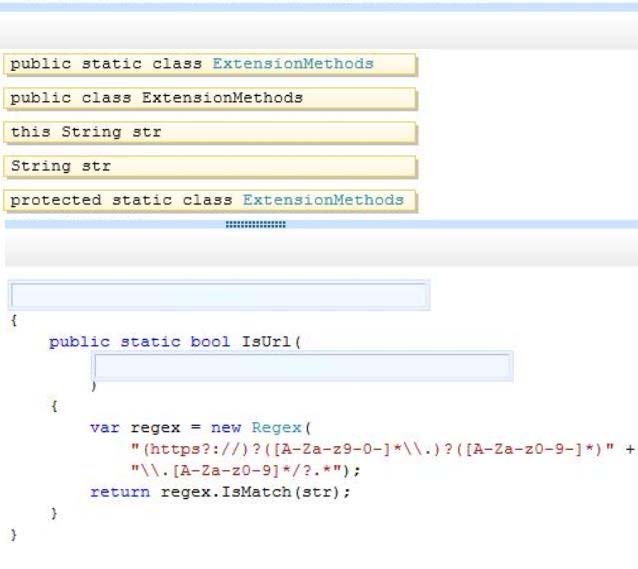
You are developing a class named ExtensionMethods.
You need to ensure that the ExtensionMethods class implements the IsEmail() method on string objects.
How should you complete the relevant code? (To answer, drag the appropriate code segments to the correct locations in the answer area. Each code segment may be used once, more than once, or not at all. You may need to drag the split bar between panes or scroll to view content.)
Select and Place:

send
light_mode
delete
Question #13
You are developing an application. The application includes classes named Employee and Person and an interface named IPerson.
The Employee class must meet the following requirements:
✑ It must either inherit from the Person class or implement the IPerson interface.
✑ It must be inheritable by other classes in the application.
You need to ensure that the Employee class meets the requirements.
Which two code segments can you use to achieve this goal? (Each correct answer presents a complete solution. Choose two.)
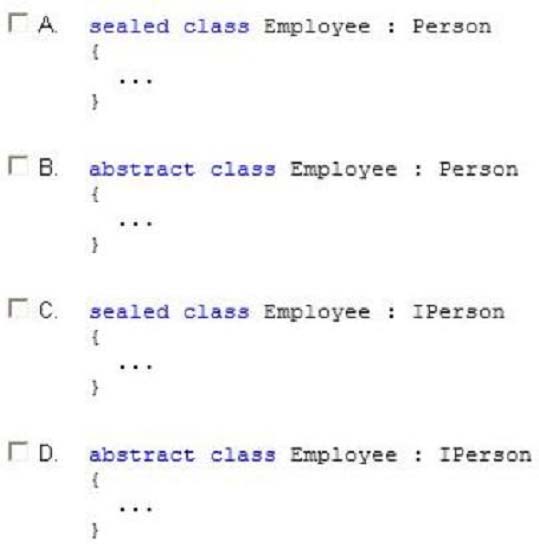
The Employee class must meet the following requirements:
✑ It must either inherit from the Person class or implement the IPerson interface.
✑ It must be inheritable by other classes in the application.
You need to ensure that the Employee class meets the requirements.
Which two code segments can you use to achieve this goal? (Each correct answer presents a complete solution. Choose two.)

- AOption A
- BOption B
- COption C
- DOption D
Correct Answer:
BD
Sealed - When applied to a class, the sealed modifier prevents other classes from inheriting from it.
References: http://msdn.microsoft.com/en-us/library/88c54tsw(v=vs.110).aspx
BD
Sealed - When applied to a class, the sealed modifier prevents other classes from inheriting from it.
References: http://msdn.microsoft.com/en-us/library/88c54tsw(v=vs.110).aspx
send
light_mode
delete
Question #14
You are developing an application that will convert data into multiple output formats.
The application includes the following code. (Line numbers are included for reference only.)

You are developing a code segment that will produce tab-delimited output. All output routines implement the following interface:

You need to minimize the completion time of the GetOutput() method.
Which code segment should you insert at line 06?
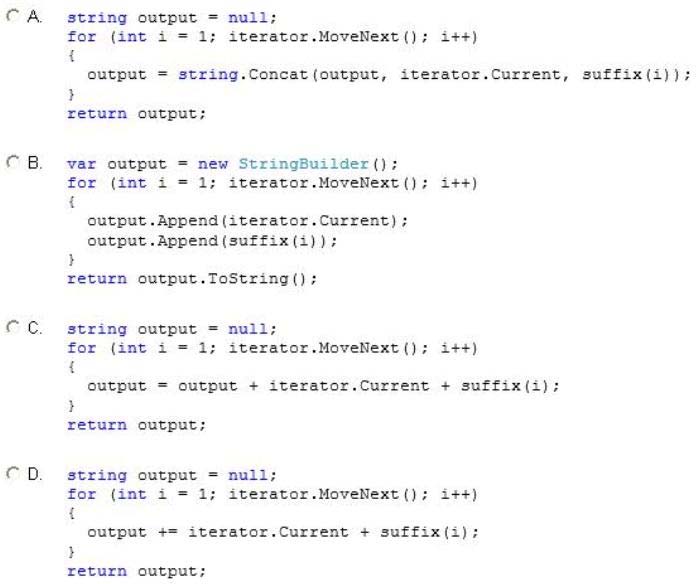
The application includes the following code. (Line numbers are included for reference only.)

You are developing a code segment that will produce tab-delimited output. All output routines implement the following interface:

You need to minimize the completion time of the GetOutput() method.
Which code segment should you insert at line 06?

- AOption A
- BOption B
- COption C
- DOption D
Correct Answer:
B
A String object concatenation operation always creates a new object from the existing string and the new data.
A StringBuilder object maintains a buffer to accommodate the concatenation of new data. New data is appended to the buffer if room is available; otherwise, a new, larger buffer is allocated, data from the original buffer is copied to the new buffer, and the new data is then appended to the new buffer.
The performance of a concatenation operation for a String or StringBuilder object depends on the frequency of memory allocations. A String concatenation operation always allocates memory, whereas a StringBuilder concatenation operation allocates memory only if the StringBuilder object buffer is too small to accommodate the new data. Use the String class if you are concatenating a fixed number of String objects. In that case, the compiler may even combine individual concatenation operations into a single operation. Use a StringBuilder object if you are concatenating an arbitrary number of strings; for example, if you're using a loop to concatenate a random number of strings of user input.
References: http://msdn.microsoft.com/en-us/library/system.text.stringbuilder(v=vs.110).aspx
B
A String object concatenation operation always creates a new object from the existing string and the new data.
A StringBuilder object maintains a buffer to accommodate the concatenation of new data. New data is appended to the buffer if room is available; otherwise, a new, larger buffer is allocated, data from the original buffer is copied to the new buffer, and the new data is then appended to the new buffer.
The performance of a concatenation operation for a String or StringBuilder object depends on the frequency of memory allocations. A String concatenation operation always allocates memory, whereas a StringBuilder concatenation operation allocates memory only if the StringBuilder object buffer is too small to accommodate the new data. Use the String class if you are concatenating a fixed number of String objects. In that case, the compiler may even combine individual concatenation operations into a single operation. Use a StringBuilder object if you are concatenating an arbitrary number of strings; for example, if you're using a loop to concatenate a random number of strings of user input.
References: http://msdn.microsoft.com/en-us/library/system.text.stringbuilder(v=vs.110).aspx
send
light_mode
delete
Question #15
You are developing an application by using C#.
The application includes an object that performs a long running process.
You need to ensure that the garbage collector does not release the object's resources until the process completes.
Which garbage collector method should you use?
The application includes an object that performs a long running process.
You need to ensure that the garbage collector does not release the object's resources until the process completes.
Which garbage collector method should you use?
- AReRegisterForFinalize()
- BSuppressFinalize()
- CCollect()
- DWaitForFullGCApproach()
Correct Answer:
B
B
send
light_mode
delete
All Pages

